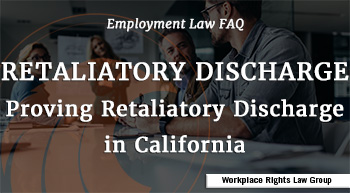
Despite the many laws and regulations that are in place to prevent wrongful practices in the workplace, things like discrimination, sexual harassment, and retaliation occur on a daily basis.
Unfortunately, because these wrongs are often slight, they are hardly ever noticed by anyone but the victim, and the offender is rarely held accountable.
At Workplace Rights Law Group, our experienced retaliation and wrongful termination lawyers want to put an end to wrongful employment practices for good, which is why we have dedicated our careers to fighting on behalf of victims of unlawful employment practices.
One area we feel particularly passionate about is retaliatory discharge or wrongful termination.
What is Wrongful Termination?
Wrongful termination occurs when an employer discharges an employee for the sole purpose of “getting even.” Typically, a retaliatory discharge occurs shortly after an employee reports wrongdoing.
Wrongdoing can be anything from reporting an incident of sexual harassment to HR to filing an employment discrimination complaint under the Fair Employment and Housing Act (FEHA).
Many instances of wrongful termination also occur after an injured employee has filed a workers’ compensation claim or engages in whistleblowing.
Retaliatory discharge is illegal and if your employer is guilty of it, he or she may be liable for lost wages, lost benefits, emotional duress, and more.
Signs of Retaliatory Discharge
Even if you were fired within weeks of filing a complaint against your employer, you may have a hard time proving retaliatory discharge in California.
This is because California is an at-will employment state, meaning that California employers can hire and fire employees at will, and vice versa—employees can quit without giving a two-week notice and without reason.
Bearing that in mind, an employee can file a wrongful discharge claim, but unless there is substantial evidence in his or her favor, he or she may have a difficult time winning the case.
Fortunately, a skilled workplace rights attorney knows what evidence is necessary to fight back and win. The first piece of evidence your lawyer may request is a timeline of events.
Though every retaliatory discharge case looks a little different, it typically looks a little something like this:
- You were discriminated against, harassed, or asked to do something outside of your scope of employment and declined, or you engaged in whistleblowing;
- You filed a claim or complaint against your employer or another employee and your employer found out;
- Not long afterward, your employer began to treat you differently, and may have demoted you, asked you to perform work usually reserved for another employer, or cut your hours or your pay in an attempt to get you to quit; and, eventually
- You were discharged.
Even if the sequence of events leading up to your termination looks slightly different, if you can prove that you filed a complaint or claim and that, shortly afterward, you were let go, you have the two essential elements of a retaliatory discharge case.
The other two essential elements you need to prove are:
- Your employer took an adverse job action against you, meaning he or she either fired you, demoted you, denied you a promotion, or created a hostile work environment; and
- There is a link between the adverse job action and the protected activity you engaged in.
Unfortunately, it is not enough to show that you were fired shortly after filing a complaint against your employer.
For all anyone else is concerned, you were let go because you were no longer performing your job duties up to par, or because you were bringing down company morale.
Remember, California is an at-will employment state, so unless your employer outwardly admits that he or she fired you in retaliation for something you did, you have your work cut out for you. You can make your job, and your attorney’s, a little easier, by gathering circumstantial evidence.
The Evidence
While circumstantial evidence is not given much weight in most cases, it is pretty much the only kind of evidence available in retaliatory discrimination cases.
For this reason, the more circumstantial evidence you have, the better.
Examples of circumstantial evidence include patterns of adverse actions towards employees who have made similar complaints, or evidence that employees who did not complain about discriminatory acts, harassment, or wrongful practices were treated better.
Another example of circumstantial evidence is an employee who routinely receives stellar employee reviews, but the first review after the complaint happens to be a negative one.
Though each of these instances can be coincidental, if there are enough of them, the jury may begin to think that they are less coincidental and more incidental.
What You Can Do
Retaliatory discharge is also damaging. Wrongful termination can ruin a person’s career, damage their future, and harm their self-worth. Aside from that, however, wrongful termination shows others that when you stand up for what is right, you get punished for it.
At Workplace Rights Law Group, our Los Angeles workplace rights attorneys are advocates for those who stand up for themselves and who are shut down because of it.
Though we can be your voice in court, we need your help. There are some things you can do to boost the validity of your case and ensure a favorable outcome.
For starters, keep a record of any negative action taken against you and any verbal or written evidence that may be relevant to your case. Write down everything, even if you believe it is a small, inconsequential detail.
Bring your concern to HR. This is important, as without evidence that you filed an official claim, you do not have a case. Ask for documentation of your claim. Both a hard copy and an email copy would be good.
Retain an attorney. A knowledgeable lawyer can assess the facts of your case, review any evidence you do have, and help you determine whether or not you have a viable retaliatory discharge claim.
If you do, he or she can help you take the next step, which is bound to be the most difficult: filing the claim.
Contact a California Employment Lawyer for Assistance
The Los Angeles workplace rights attorneys at the Workplace Rights Law Group are prepared to help you stand up for your rights and fight back against illegal employment practices.
If you decide to pursue a claim against your former employer, call our team at (818) 844-5200 or contact us online to get started.
